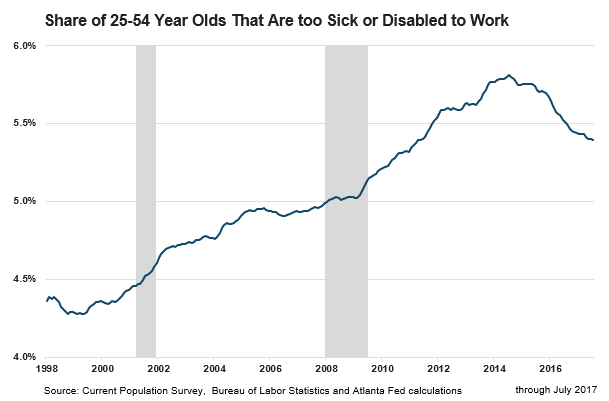ECONversation Explores Effects of Poor Health on the Labor Force
During the past 20 years, poor health has kept a growing share of Americans out of the labor force, according to research by the Federal Reserve Bank of Atlanta economic policy analysis specialist Ellie Terry.
Terry spoke about her work in a recent ECONversation webcast. In the monthly Current Population Survey (CPS) conducted by the U.S. Bureau of Labor Statistics and the U.S. Census Bureau, since 1997 increasing proportions of respondents reported they are too sick or disabled to work or seek a job. However, that share has dipped over the past year, which is a positive sign, Terry said. (see the chart below)
Bad health top reason men are out of the labor force
But ill health remains a serious labor market concern. Among men in the CPS, poor health or disability is the number one reason for not participating in the labor force, Terry noted. Meanwhile, health issues rank a close second behind caring for home or family among factors keeping women aged 25 to 54 out of the labor force.
 Their absence matters to the macroeconomy. The labor force participation rate, or LFPR, is critical to economic growth, Terry explained. The LFPR is 63 percent, still 3 percentage points below the rate just before the Great Recession began in 2007. After controlling for demographic factors such as aging, Terry determined that about half of that three-point gap is the result of behavioral and cyclical reasons, including health problems and disability.
Their absence matters to the macroeconomy. The labor force participation rate, or LFPR, is critical to economic growth, Terry explained. The LFPR is 63 percent, still 3 percentage points below the rate just before the Great Recession began in 2007. After controlling for demographic factors such as aging, Terry determined that about half of that three-point gap is the result of behavioral and cyclical reasons, including health problems and disability.
While 1.5 percentage points may sound trivial, it equates to about 4 million people who are out of the labor force. A large number of those 4 million say they are on the sidelines because of poor health or disability.
"So if you think some portion of those 4 million people would be working ... then those people are potentially very important for economic growth," Terry told ECONversation moderator Charles Davidson, a staff writer for the Atlanta Fed's Economy Matters digital magazine.
Different regions, different problems
The severity of the problem differs by geography and education level. For example, in Utah just 3 percent of CPS respondents say they are too sick for the work force, the lowest reading among states in 2016. At the other end, Mississippi had the highest level at 13 percent. The rates are also high throughout Appalachia, Terry said. Across states, those who didn't graduate from college are far more likely than those with a degree to report leaving the labor force because of bad health or disability.
It's not entirely clear what health problems are keeping people on the sidelines. However, high blood pressure and diabetes are the two conditions most closely correlated with lower labor force participation, Terry said.


